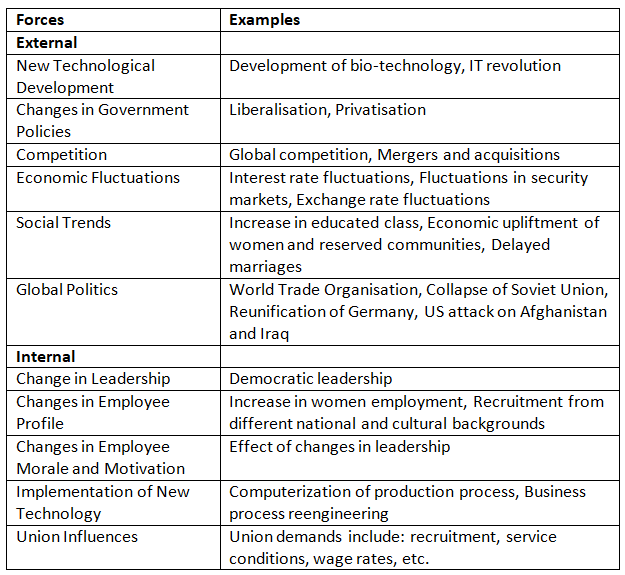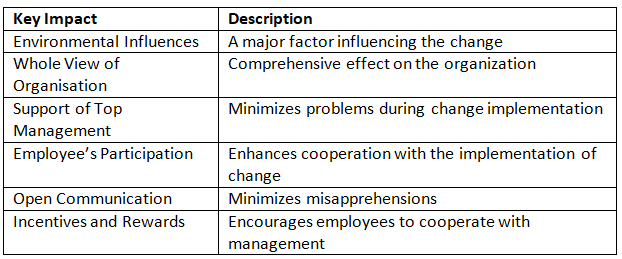Management of Change | Commerce & Accountancy Optional Notes for UPSC PDF Download
| Table of contents |

|
| Forces of Change |

|
| The Process of Change |

|
| Resistance to Change |

|
| Overcoming Resistance to Change |

|
| Managing Change |

|
Forces of Change
In today's dynamic and ever-changing business environment, organizations must undergo appropriate modifications periodically to stay competitive, enhance customer service, keep up with the latest technology, and maintain or improve current profit levels. The forces instigating these changes can be broadly categorized as Internal Forces and External Forces.
Let's explore them in detail:
Internal Forces
- Change in Leadership: Alterations in organizational leadership can lead to shifts in perspectives, strategies, activities, and outcomes.
- Change in Employees Profile: Inevitable changes in the employee profile occur due to factors like death, retirement, transfers, promotions, discharges, or resignations. The rising trend of women employment and the globalization context, where employees come from diverse national and cultural backgrounds, necessitate a reorientation of human resource policies.
- Change in Employees Morale and Motivation: Leadership changes and associated policies may impact employee morale and motivation, potentially leading to reduced productivity, production, and profits.
- Union Influence: Despite government liberalization policies, union influence persists in many organizations, affecting recruitment, service conditions, and wage rates. Management must adapt to meet union demands.
- Implementation of New Technology: Technological advancements, such as increased computerization, automation, and reengineering programs, bring significant changes to job roles, production processes, and employee profiles. The Internet and biotechnology also contribute to substantial organizational transformations.
External Forces
- Competition: Global competition is on the rise, with an increase in mergers and acquisitions. Organizations must respond to competitive demands by developing new products quickly and efficiently, requiring flexible and responsive systems.
- Economic Fluctuations: Fluctuations in security markets, interest rates, and exchange rates continue to impose changes on organizations.
- Social Trends: Social trends like increased college attendance, delayed marriages, economic upliftment of women and backward communities suggest changes that organizations need to consider, impacting the demand for products used by these groups.
- Global Politics: Events such as the collapse of the Soviet Union, the reunification of Germany, policies of international organizations like W.T.O., and geopolitical actions like U.S. attacks on Afghanistan and Iraq have profound impacts on businesses related to these developments.
Look at the Table below which shows all the internal and external forces initiating changes:
Forces of Change
The Process of Change
A successful change process encompasses three key steps:
- Identifying the Need for Change: Recognizing the necessity for change is the initial step.
- Cultivating a New Behavior or Substitute: Developing and fostering a new behavior or alternative is the second crucial step in the change process.
- Feeling Comfortable with the New Situation: Achieving a sense of comfort and acceptance with the new situation constitutes the final step.
Now, let's explore the Lewin's three-step model, which outlines the change process:
Lewin's Model
According to Kurt Lewin, the change process involves three distinct steps:
- Unfreezing the Status Quo: This step focuses on making people realize the necessity for change. Environmental pressures, declining performance, problem recognition, or the availability of a better approach can expedite the unfreezing process. Encouraging driving forces for change while discouraging resistance forces is crucial. Changes introduced without undergoing the unfreezing process are prone to failure due to employee unawareness and resistance.
- Movement to a New Stage: The second stage involves taking action to modify the situation, including changes to people, tasks, organizational structure, and technology.
- Refreezing the New Change: The final stage, refreezing, aims to make the new tasks, technologies, and relationships relatively permanent. This stage reinforces and stabilizes the introduced changes. Failure to complete the refreezing stage may result in the abandonment or incomplete implementation of the introduced changes shortly after implementation.
Continuous Process Model
- The Lewin's model, while simple, lacks coverage of several crucial aspects. As a result, the continuous change process model has emerged to address these limitations. This model approaches change from the perspective of top management.
- In this continuous change process model, top management identifies forces or trends necessitating change, engaging the organization's usual problem-solving and decision-making processes. Goals are defined, and alternatives for change are evaluated, with the chosen one implemented following Lewin's model.
- Top management may enlist the support of a change agent, responsible for overseeing the change effort, whether from within the organization or an external party. Internal change agents possess familiarity with the organization, while external agents offer a more objective view. Guided by the change agent, the organization implements change through the Lewin's model.
- The final step involves measurement, evaluation, and control, where top management assesses the change process's effectiveness by evaluating indicators like organizational productivity or employee morale.
- Employee adjustment to even minor changes takes time, and more effort is required for complex changes. Transition management systematically plans, organizes, and implements change, ensuring business continuity during the transition period. The regular management team assumes the role of transitional managers, coordinating organizational activities with the change agent. Effective communication about the change is a crucial component of transition management.
Resistance to Change
- Resistance to change refers to an unwillingness or reluctance, either in attitude or behavior, to accept a specific change. Overcoming this resistance is crucial for the successful implementation of change initiatives. It's important to recognize that resistance can also provide valuable feedback, offering an opportunity to reassess proposed changes for the benefit of the organization.
- Taking a constructive approach to resistance involves carefully considering objections raised, making necessary adjustments, and educating employees about the intended changes. Resistance can manifest in various forms, such as overt, implicit, immediate, or deferred. Addressing overt and immediate resistance allows management to take prompt corrective measures. Implicit resistance may lead to issues like loss of loyalty, decreased motivation, increased errors, and higher absenteeism over time. Deferred resistance becomes problematic, especially when significant resources have already been invested in implementing the change. Resistance to change can originate from the organization, the individual, or both.
We shall now examine the different sources of resistance either from organisation or from individuals.
Organisational Resistance
Six primary sources of resistance within an organization have been identified:
- Structural Inertia: Organizations inherently possess mechanisms and systems designed to maintain stability. These can include training, established procedures, and other socialization techniques. Employees, accustomed to these systems, may resist proposed changes to them.
- Limited Focus of Change: Organizations are comprised of interconnected subsystems. Attempting to change one subsystem without concurrently modifying others may result in resistance, as the entire organization is not considered in the change process.
- Group Inertia: Even if individuals are open to changing their behavior, group norms can serve as a constraint, hindering the acceptance of change.
- Threat to Expertise: Changes in organizational processes may pose a threat to the specialized expertise developed by individuals and groups over time, leading to resistance.
- Threat to Established Power Relations: Any redistribution of decision-making authority can jeopardize established power relationships among individuals, fostering resentment and resistance to change.
- Resource Allocation: Groups within the organization that control resources may view change as a threat to their control, resulting in resistance.
Individual Resistance
Individual resistance to change often stems from fundamental human characteristics, including perceptions, personalities, and needs.
The six reasons for individual resistance are as follows:
- Habit: Humans tend to prefer performing their daily tasks in familiar ways, and the introduction of new steps is often perceived as making the job more challenging, leading to resistance.
- Security: Individuals with a strong need for job security may resist changes that could impact their feelings of safety. Introduction of new technologies, for example, may create a sense of job insecurity among employees.
- Economic Factors: Resistance may arise when employees believe that proposed changes could reduce their monthly pay, prompting opposition to such changes.
- Fear of the Unknown: Proposed changes often replace a known situation with an ambiguous and uncertain one. Employees may develop a negative attitude towards the change due to the fear of the unknown.
- Lack of Awareness: Resistance may occur when people are unaware of the benefits associated with proposed changes, leading to opposition stemming from ignorance.
- Social Factors: Individual employees might resist changes influenced by their group or union affiliations. The fear of being ridiculed by colleagues or union officials may contribute to resistance to accepted changes.
Overcoming Resistance to Change
When faced with resistance to change, management should adopt appropriate measures to address and overcome it.
Six methods have been suggested for dealing with resistance:
- Education and Communication: Overcoming resistance begins with educating and communicating with employees before implementing the change. Providing information helps them understand the rationale behind the change and its benefits. This approach is effective when resistance is rooted in inaccurate or incomplete information.
- Participation and Involvement: Actively involving concerned employees in the decision-making process can significantly reduce resistance. When employees participate in the decision, they are more likely to support its implementation, considering it their own proposal.
- Facilitation and Support: This involves providing emotional, training, and financial support to employees facing hardships due to the change.
- Negotiation and Incentives: By negotiating with concerned employees and offering incentives, resistance to change can be mitigated.
- Manipulation and Co-optation: Attempts to influence employees, particularly opinion makers, can be made through special benefits, providing attractive information, or withholding undesirable information.
- Coercion: The application of direct threats or force on resisters, which may include transfer, loss of promotion, or retrenchment.
Look at the Table below which shows methods of overcoming resistance to change:
Overcoming Resistance to Change
Managing Change
In conclusion, the successful management of organizational change is influenced by several factors.
These six factors include:
- Environmental Influences: The environment plays a crucial role in instigating organizational change. The organization must consider the demands of the environment, and the complexities increase as the scope of operations extends from local to global levels. The acceptance of change also varies across different cultures and regions, requiring diverse management approaches.
- Whole View of the Organization: Managers must adopt a comprehensive view of the organization when proposing changes. A narrow perspective can negatively impact change efforts.
- Support of Top Management: The success of any change initiative relies significantly on the support of top management. Complaints against proposed changes by local or regional managers may be directed to top management. Hence, it is crucial to inform and secure the support of top management beforehand to prevent implementation challenges.
- Employee’s Participation: Involving employees or their representatives in discussions about proposed changes can enhance cooperation. Granting employees a role in designing the change fosters their cooperation during implementation.
- Open Communication: Maintaining open communication between management and employees is vital for successful change management. Employees may have misconceptions about the change, and accurate information needs to be provided through transparent communication to avoid failure in change efforts.
- Incentives and Rewards: Recognizing and appropriately rewarding employees responsible for the successful implementation of change is essential. Those actively supporting and assisting others in adjusting to changes deserve special acknowledgment, such as news releases, consideration in performance appraisals, pay increments, or promotions.
Look at the Table below which shows the factors and impact of managing change.
Managing Change
|
196 videos|219 docs
|
FAQs on Management of Change - Commerce & Accountancy Optional Notes for UPSC
| 1. What are the forces of change? |  |
| 2. What is the process of change? |  |
| 3. What is resistance to change? |  |
| 4. How can resistance to change be overcome? |  |
| 5. How can change be effectively managed? |  |















